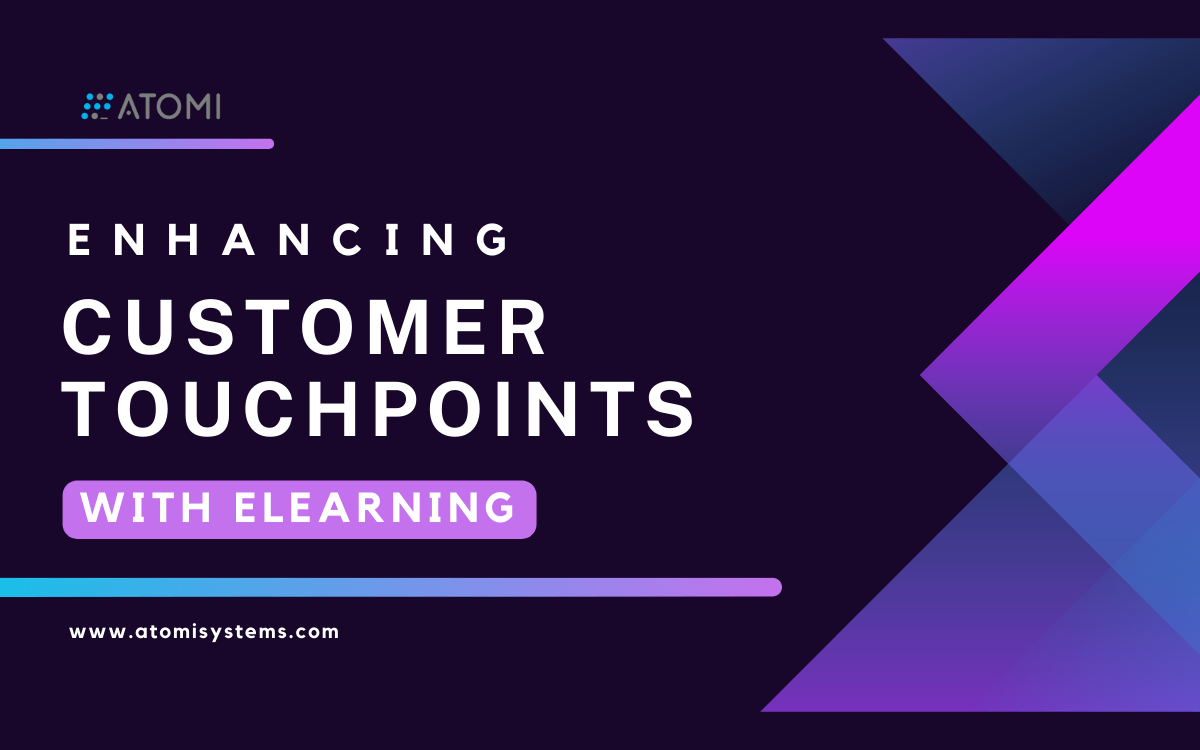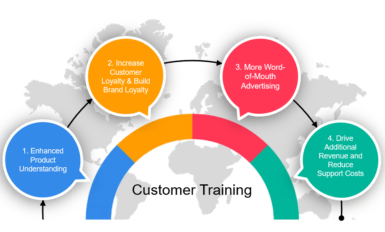In this blog, we explore the transformative potential of eLearning in enhancing customer touchpoints. Discover how businesses can leverage eLearning strategies to create meaningful interactions, boost customer engagement, and forge lasting connections with their audience.
In today’s rapidly evolving digital landscape, eLearning has emerged as a powerful authoring tool for businesses seeking to enhance their customer touchpoints. By integrating eLearning strategies into various stages of the customer journey, companies can create more personalized interactions. From pre-purchase education to post-purchase support, leveraging eLearning techniques opens up a world of opportunities to engage customers, foster brand loyalty, and deliver exceptional experiences.
In today’s blog, we will explore some innovative ways to incorporate eLearning into customer touchpoints, revolutionizing how businesses connect with their audience in the virtual age.

What are Customer Touchpoints?
Customer touchpoints are the various points of interaction and communication between a customer and a business throughout the customer journey. These touchpoints can occur through different channels and platforms, both online and offline, and play a crucial role in shaping the overall customer experience. Each touchpoint presents an opportunity for the business to engage with customers, address their needs, and influence their perceptions of the brand.
Common Customer Touchpoints
Let’s explore the most common customer touchpoints and their significance in enhancing overall customer satisfaction.
- Website: Your company website is often the first point of contact for potential customers, where customers can learn about products, services, and company information.
- Social media: Interactions on social media platforms like Facebook, Twitter, and Instagram allow businesses to engage with customers directly.
- Customer service: The customer service experience can make or break a customer’s perception of your brand. Communication with customers via email, chat, community, or social media is a critical touchpoint for issue resolution and customer satisfaction.
- Physical store/Office: For brick-and-mortar businesses, the in-store experience is a significant touchpoint. A clean and inviting ambiance, knowledgeable staff, and personalized assistance create a positive association with your brand.
- Mobile apps: Interactions with the business’s mobile app, if available, provide customers with personalized experience and convenience.
- Online Ads: Ads displayed on search engines, social media platforms, or other websites can be touchpoints that attract customers to the business.
- Product packaging: The packaging is an extension of your brand identity. Strive for visually appealing, eco-friendly, and functional packaging that delights customers upon receiving their orders.
- Online reviews and Testimonials: Customer reviews and testimonials can influence potential buyers. Encourage satisfied customers to share their experiences, and respond graciously to any negative feedback.
- Word-of-mouth: Recommendations and reviews from friends, family, or online communities are essential touchpoints that influence customers’ decisions.
Customer Journey Touchpoints
Customer touchpoints in customer experiences can be categorized into three main stages: before purchasing, while purchasing, and after purchasing. Each stage represents specific interactions that businesses have with customers, and these touchpoints collectively shape the overall customer experience. Before making a purchase, customers may come across the brand through various advertising channels. For example, visit the website, interact with social media posts, and read customer reviews. During the purchase process, brick-and-mortar businesses engage customers at the point of sale. Meanwhile, e-commerce companies provide a seamless online shopping cart and checkout experience. After the purchase, businesses ensure smooth order confirmation and shipping processes, offer onboarding and support for products or services and encourage customers to leave feedback and reviews. Managing these touchpoints effectively enables businesses to create a positive and cohesive customer experience, fostering loyalty and satisfaction.
Ways to Engage eLearning to Effectively Increase Customer Touchpoints
In today’s technology-driven era, online purchasing is on the rise, prompting customers to research products and services online before making any purchase decisions. Therefore, providing detailed information about offerings online not only aids in quick understanding but also builds customer trust. To increase customer touchpoints, businesses adopt various strategies tailored to their products. Engaging eLearning is one such strategy, as it fosters dynamic learning experiences and encourages long-term brand engagement. To gain a comprehensive understanding of the benefits and implementation of eLearning, the following strategies will guide you effectively.
Interactive, Personalized, and Mobile-accessible Content
We can observe a progressive increase in engagement across three levels: interactive, personalized, and mobile-accessible content.
At the first level, we have interactive content, where static information is transformed into exciting elements like quizzes, simulations, and interactive videos. This approach directly involves learners, making the learning experience dynamic and immersive. When learners can engage with the material firsthand, they understand and retain it better.
Moving up to the second level, we have personalized content, which takes learning to a whole new level of customization to meet individual needs. Using customer data and insights to create personalized learning paths, course recommendations, and targeted content. By making the learning journey unique to each customer, you demonstrate that you truly understand and cater to their specific requirements.
The last level is mobile-accessible content. With the increasing use of smartphones and tablets, it’s crucial to have an eLearning platform that’s mobile-friendly and accessible on various devices. By offering mobile access, you allow your customers to learn on the go and at their convenience. This flexibility boosts touchpoints, as customers can engage with your eLearning content anytime, anywhere.
Gamification
Another way to engage eLearning in customer touchpoints is gamification. By using gamification elements into your eLearning platform, you can make the learning process more fun and engaging. Implement features like points, badges, leaderboards, and challenges to create a sense of achievement and healthy competition among learners. Gamification motivates customers to complete courses, earn rewards, and encourage them to continue learning.
Regular Updates
Once you’ve developed interactive eLearning content that suits your business needs, it’s essential to ensure its freshness and relevance by regularly updating it. This shows customers that you are committed to providing relevant and valuable information. By keeping the content up-to-date, you provide a compelling reason for customers to come back to your platform, increasing more touchpoints and reinforcing their connection with your brand.
Customer Support
During their learning journey, customers may need support on how to use your products. Therefore, it’s essential to provide excellent customer support throughout the eLearning journey. Being responsive and helpful through live chat, email, or phone, can make a significant difference in a customer’s overall experience. Addressing queries and concerns promptly not only builds trust but also ensures that customers feel supported throughout their learning process.
Design eLearning Content to Enhance Customer Touchpoints
Having covered the key characteristics of customer touchpoints and the importance of incorporating eLearning into these interactions, there remains one crucial question: How do you design eLearning content to effectively enhance customer touchpoints? An eLearning authoring tool like ActivePresenter will be helpful in this case.

ActivePresenter is a powerful eLearning authoring tool that empowers businesses to design interactive content to enhance customer touchpoints. With its user-friendly interface and comprehensive features, ActivePresenter offers a seamless experience for creating interactive and personalized eLearning materials. Through this software, businesses can convert static content into dynamic elements. They can be quizzes, simulations, and interactive videos, providing learners with an engaging and immersive experience. By leveraging ActivePresenter’s capabilities, companies can deliver relevant and valuable information to their customers. Whether it’s pre-purchase education or post-purchase support, ActivePresenter enables businesses to create tailored learning paths and course recommendations based on individual needs. Therefore, demonstrating a deep understanding of their customers’ requirements. This results in increased touchpoints and reinforces the connection between the brand and its audience. As a result, ActivePresenter proves to be an invaluable asset in revolutionizing how businesses connect with their customers in the virtual age.
Final Thoughts
Embracing engaging eLearning in customer touchpoints can be a game-changer for businesses. By integrating interactive, personalized, and mobile-accessible content, companies can create dynamic learning experiences that resonate with their audience. With a software like ActivePresenter, tailored eLearning content can enhance touchpoints, foster brand loyalty, and provide exceptional experiences. As businesses strive to connect with their customers in the virtual age, leveraging eLearning in customer touchpoints emerges as a powerful and effective strategy to forge meaningful connections and stay ahead in the competitive landscape.
Table of Contents
Follow us on Social Media:
See also:


